Top News

December 1, 2012 Ryukyu Shimpo
December 1 marked two months having passed since the United States deployed the MV-22 Osprey aircraft squadron to U.S. Marine Corps Air Station Futenma. There are still strong voices being raised among Okinawan people seeking the withdrawal of the Osprey. Starting with the Ginowan citizens’ rally held in June, a mass rally by Okinawans was held on September 9. After that, 24 municipalities have held a total of 21 rallies, including those held on remote islands on the same day as the Okinawan people’s mass rally. Other municipalities are also looking to hold rallies. Early next year, the organizing committee for the Okinawan peoples’ rally is scheduled to request that the government take action.
Residents are unhappy with the current situation of Osprey flying throughout the prefecture, and are concerned about noise pollution and possible accidents. The Okinawan peoples’ movement seeking to have the MV-22 squadrons withdrawn indicates that momentum is building throughout the prefecture.
Every day civic groups carry out a sit-down protest and rallies opposing the Osprey deployment. Every Friday evening, the Okinawa Peace Movement Center holds an ongoing protest rally in front of the Nodake Gate of MCAS Futenma. On November 30, in the rain, about 100 people called for the removal of the Osprey from Okinawa. In a hard-hitting speech, Naoshi Kadekaru, the chairman of the Central District Labor Organization, said, “Let’s show the children of Okinawa that we can be victorious in having the Osprey withdrawn.”
Uruma resident Hiyori Mekaru who participated in the rally, said, “The governments trampled on the will of the people that was displayed by 100000 people in the mass rally to oppose the deployment of the Osprey. Residents continue to be victims in this. We must not allow the bases to remain as a problem for our children to inherit. “ Mari Nishimoto, a student of Okinawa International University, showed her indignation, saying, “Osprey flights violate the agreement established between the United States and Japan to ensure safety since the aircraft were deployed to Futenma Air Station. It makes me really angry.” On December 23, the Okinawa Peace Movement Center and the Okinawa
United Action Liaison Council (Toitsuren), will hold a rally for around 10000 people at the Open Theater in Ginowan Seaside Park.
(English translation by T&CT, Mark Ealey)
Go to Japanese

December 1 2012 Ryukyu Shimpo
On November 30, in a routine interview, Okinawa Governor Hirokazu Nakaima made reference to the assertion by top officials of the Liberal Democratic Party’s headquarters that they would construct the alternative facility for the relocation of Futenma Air Station to Henoko, Nago before the election for the House of Representatives. He said, “Whatever the composition of the next administration, I will not change my position, and will strive to see it fulfilled.” Asked whether or not his position represents his pledge to have Futenma Air Station relocated outside of Okinawa, Nakaima said, “Indeed it does.” Nakaima asserted that he would stick to his pledge even if the Liberal Democratic Party, which seeks to relocate the base within the prefecture, assumes power.
Nakaima then commented on the Democratic Party of Japan’s three-year administration as a whole, saying, “In terms of the promotion of the Okinawa economy, I think that the Act on Special Measures for the Promotion and Development of Okinawa is very good, as is the Reuse of the U.S. Military Facilities upon their Return to Japan.” However, Nakaima said, “I had great expectations that the central government would move to review the Japan-U.S. Status-of-Forces Agreement, but they have yet to do anything about it.”
With regard to the issue of the U.S. military bases in Okinawa, Nakaima said, “I expected the central government would ease the excessively heavy burden that the presence of the U.S. military places on Okinawa, but unfortunately they have done nothing.”
In reference to the U.S. military’s plan to complete deployment of Osprey aircraft to Okinawa in the beginning of December, Nakaima said, “I have continued to state that it is impossible for the U.S. Marine Corps in Okinawa to abide by the safety measures proposed by the Japan-U.S. Joint Committee, such as avoiding flights over residential areas, and that is still my position.”
Nakaima intends to check with the central government how the U.S. military will deploy the Osprey, saying, “The U.S. military has in no way eased the concerns regarding the safety of Osprey aircraft that have recently crashed. I will follow developments, and will request that the Japanese government report on this and provide a proper explanation of the situation.”
(English translation by T&CT, Mark Ealey)
Go to Japanese
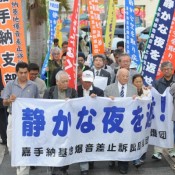
December 1, 2012 Ryukyu Shimpo
With regard to ongoing legal action in which about 22000 residents living around the U.S. Kadena Air Base claim that the U.S. government is responsible for health problems arising from the presence of the base, 144 residents initiated a lawsuit against the White House at the Okinawa Branch of the Naha District Court on November 30. In it they demand a ban on flights at night and in the early morning hours and also demand compensation for damages and losses caused by the practices of the U.S. military. This is the second time that residents have brought a lawsuit directly against the U.S. government since they demanded a ban on flights in the second lawsuit lodged. It is the first time for them to demand compensation.
According to the bill of complaint, the plaintiffs have taken legal action against the U.S. government, demanding a ban on flights to and from the base during the period from 7:00pm until 7:00am the next day. They also request that the military not generate more than 40 db of aircraft noise around the residential area from 7:00pm to 7:00am, and 65 db during the daytime hours of 7:00am to 7:00pm. Each of the plaintiffs demand 1.5 million yen in compensation, and the total payment requested amounts to 216 million yen.
In the second lawsuit, the U.S. government refused to accept the bill of complaint, so the court never held an oral hearing, dismissing the case under the sovereign immunity clause.
The residents have brought the lawsuit against the U.S. government based on the law implemented in 2010 that enables plaintiffs to file a civil complaint against foreign governments.
(English translation by T&CT, Mark Ealey)
Go to Japanese
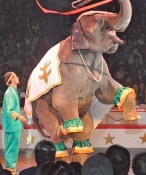
December 2, 2012 Ryukyu Shimpo
On December 1, commemorating the 120th anniversary of the establishment of the Ryukyu Shimpo, at a special venue in Toyosaki in Tomigusuku, the Kinoshita Circus performed for the first time in eight years since it was last held in the new commercial district of Naha in 2004. On the opening day, there were long lines of people who had been looking forward to the performance, and the venue was crowded with family groups. Two performances were held following the opening ceremony, and both were full to capacity, with about 4000 people packing into the venue on the first day.
The spectators were captivated by the show with its thrills, excitement and comedy, enjoying the fantastic atmosphere that the circus created.
Performances will be held until February 3 next year, but not on December 31, January 9 and on Thursdays (except Thursday, January 3).
For further information, telephone the information desk for the Kinoshita Circus in the Ryukyu Shimpo on 098 851 0900.
(English translation by T&CT, Mark Ealey)
Go to Japanese

Go To Video
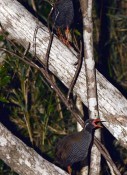
November 17, 2012 Ryukyu Shimpo
A pair of Yambaru kuina or endangered Okinawa Rail have been found in the watershed area of the Taiho Dam in Ogimi.
According to the Yambaru Wildlife Conservation Center, the southern limit of the Yambaru kuina’s range is the northern part of Ogimi and the area around the Taiho Dam. The last time a pair of Yambaru kuina was seen was twelve years ago in 2000.
A staff member from the center said that the mongoose control plan is going well, and commented, “We are looking forward to the breeding season.”
On October 30, the NPO Animal Hospital Okinawa in Uruma confirmed the existence of the pair of Yambaru kuina. The hospital mentioned that a male Yambaru kuina had been living in the Taiho Dam watershed basin for 10 years and had paired up with a female that had moved down from the northern area of the bird’s range.
Vice director of the hospital Michio Kinjo also said, “Finding this pair of Yambaru kuina, indicates that the mongoose control plan is proving to be effective.”
(English translation by T&CT, Hitomi Shinzato and Mark Ealey)
Go to Japanese

November 27, 2012 Ryukyu Shimpo
On November 21, at the Komesu Community Center in Itoman, a group was set up to plan the construction of the John Manjiro Memorial Monument at the site of his first landing at Odo in Itoman. John Manjiro, who served as an interpreter in the late Edo period also referred to as the end of the Tokugawa Shogunate, landed on Odo beach, in Itoman, on his way back to Japan, after living more than ten years in the United States. Chosei Yamazato, the head of Itoman Municipal Social Welfare Council, was appointed the chairman of the association, and 104 people including Itoman Municipal Assembly members and residents of the Komesu and Odo districts joined the organization. They aim to raise funds to erect the monument and will ask the Itoman Municipal Office and the Okinawa Prefectural Government for assistance.
Manjiro lived in the United States for many years after he was rescued by an American whaling ship when he went missing on a fishing boat during his childhood. In 1851, because he was unable to return directly to Japan, which had an isolationist policy in place at that time, he landed on Odo beach, in the Mabuni-magiri district of the Ryukyu Kingdom, and then spent six months at Onaga-magiri (currently Tomigusuku City). After returning home he worked as an interpreter for the Tokugawa Shogunate, and also contributed to the establishment of modern Japan through his interaction with patriots such as Ryoma Sakamoto at the end of the Edo period.
The association hopes to utilize the Manjiro monument as a resource for tourism and education. In the meeting, it was also proposed to restore the Mabuni-magiri facility in which officials of the Ryukyu Kingdom questioned Manjiro for the first time.
According to Hideo Tokumoto, deputy chairperson of the association, in Manjiro’s birthplace of Tosashimizu, Kochi Prefecture, residents were promoting activities by a public-private partnership to ask NHK to air a dramatized portrayal Manjiro’s life among its long-running drama series, and that there was a plan for a film adaptation in future. Tokumoto emphasized, “There is momentum for re-evaluating the significance of Manjiro, so the timing of constructing this monument is significant.”
Itoman Mayor Hirotsune Uehara commented, “You could say that the dawn of the modern age of Japan started from Odo beach. We will be supporting the construction of the monument.”
(English translation by T&CT, Mark Ealey)
Go to Japanese
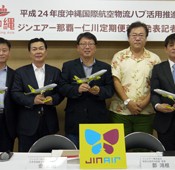
November 17, 2012 Ryukyu Shimpo
On November 16, the low-cost airline Jin Air, a subsidiary of Korean Air, announced that they will commence seven weekly flights between Seoul and Naha from December 24. Currently this route is only serviced by Asiana Airlines.
Jin Air uses the Boeing 737-800 aircraft, which have about 180 seats. The company aims to have flights running to 75-percent capacity. Besides the Okinawa route, they started a Seoul-Sapporo service in July 2011.
To create of point of difference from Asiana Airlines, Jin Air offers the low, internet transaction round-trip price of 4900 yen, which excludes tax and fuel surcharges. They serve in-flight meals, will carry 20 kilograms of baggage for free, and will have a Japanese-speaking cabin attendant on board each flight. The tickets will be on sale from November 19 through the company’s website and Jumbo Tours, a travel agency with its head office in Naha.
In a press conference held at the Okinawa Prefectural Office, the managing director of the company, Hong-Geun Chong, said that they hope to develop new customers for their business. “We hope that many people who have never been to Okinawa because of the high price of airfares will be able to visit there.” He also stated that they are thinking of increasing the number of flights to match demand, and also using New Ishigaki Airport, which is scheduled to open next year.
(English translation by T&CT, Lima Tokumori and Mark Ealey)
Go to Japanese
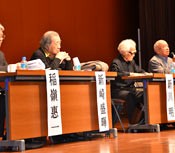
November 26, 2012 Ryukyu Shimpo
On November 25, at Hosei University in Tokyo, a symposium was held to commemorate the 40th anniversary of Okinawa’s reversion from U.S. rule to Japanese sovereignty. Former governors of Okinawa, such as Masahide Ota and Keiichi Inamine, journalist Akira Arakawa, and former president of Okinawa
University Moriteru Arasaki participated in the symposium as panel members. Looking back over the history of Okinawa before and after the war, and the current situation of Okinawa as it marks the 40th anniversary of reversion to Japanese sovereignty, the panelists pointed out that the U.S. and Japanese governments are guilty of structural discrimination against Okinawa. They stressed the importance of securing the right to self-determination and asked what Okinawa’s reversion to Japanese sovereignty actually means.
Ota talked about the factors that prevent the problems surrounding the U.S. military bases in Okinawa from being resolved, saying, “These problems could be swiftly solved if lawmakers elected from other prefectures, who make up the vast majority of Diet members, were to see the issues that Okinawa has as their own. However, they do not. That’s why I said Okinawa is the object of structural discrimination.”
With regard to former Prime Minister Yukio Hatoyama’s pledge to relocate Futenma Air Station outside of Okinawa, Inamine said, “The people in the main islands of Japan and Okinawa criticized Hatoyama for not keeping his pledge.
However, the Okinawan people criticized him for failing after he had promised to relocate the base at least outside of the prefecture. I do not think it was wrong for Hatoyama to have put the issue of U.S. military bases in Okinawa, such as the relocation of Futenma, on the national agenda for discussion.” Furthermore, Inamine said that because of Hatoyama’s remarks, the majority of Okinawan people now demand the relocation of the base outside of Okinawa, and that trend will be difficult to reverse.
Arakawa, who opposed Okinawa’s reversion to Japanese sovereignty around 1972, pointed out that there is a limit to how Okinawa can assert autonomy against the central government, saying, “Okinawa would have to be independent in order to secure the 100 percent right to self-determination. The central government would eventually crush regional voices by exerting its judicial, administrative and legislative powers.”
Arasaki said, “The Japanese government uses its power to bring Okinawan people to terms, which leads to structural discrimination against the prefecture. That’s how the central government creates its dependency on the United States.” Arasaki explained that Okinawan people who support the Japan-U.S. Security Treaty are increasingly intolerant of discrimination against Okinawa, and are moving to cooperate with people who oppose the treaty.”
(English translation by T&CT, Mark Ealey)
Go to Japanese
November 8, 2012 Fumitetsu of Ryukyu Shimpo
On November 7, Orion Breweries announced that they are going to launch a new business enterprise in the electric power industry. Aiming to get government certification for the plants, two in Nago and another one in Itoman, by March 2013, they plan to build solar power facilities capable of generating a total of five-megawatts. The project will be the largest new energy power-generating capacity in the prefecture.
Orion Breweries plans to start selling the energy to power corporations from the end of next year, and expect to earn about 200 million yen in revenue. On November 7 the plan was discussed at a special shareholders’ meeting, in which they approved the partial amendment of the company’s articles of incorporation.
This is the first time in Okinawa that a food and beverage manufacturer has started such a cross-industrial business operation. Yoshio Kadekaru, the president of the company, said, “The national government is also helping to promote this. We want to keep pace with current trends.” Ongoing research is occurring to decide the sites for construction, and they expect to further expand the scale of the operation.
The feed-in tariff system for renewable energy was introduced this July, and already has had an impact on the electric power industry. Orion Breweries Ltd. is looking throughout the prefecture for potential sites for their energy generators.
According to officials, the original investment is 1.5 billion yen, and the facility is expected to be operational for 25 years. The investment efficiency yield will be six to seven percent. The two facilities in Nago will be constructed at ground level and the one in Itoman will be installed on the top of a building roof.
(English translation by T&CT, Kyoko Tadaoka and Mark Ealey)
Go to Japanese
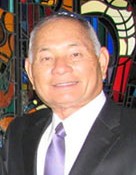
November 19, 2012 Sadao Tome Correspondent of Ryukyu Shimpo
On November 11, the Okinawa Association of America held its annual general meeting, in which it elected Shingi Kuniyoshi as its new president. Kuniyoshi will serve for two years from 2013. The association held the election at the end of the term of the former president Kimiko Goya, who served in the role from 2011.
Kuniyoshi will officially assume the position as of the New Year’s party and the inauguration ceremony, which will be held in next January. Kuniyoshi also served as the president from 1997 to 1998, so this is the second time that he has carried out the role. The association elected a total of seven executive board members in the election.
Next year the association will mark the 100th anniversary of its establishment. It lives up to its name as the leader of the more than 30 associations that exist in the North American continent, and is a role model for associations of other prefectures. The association has three buildings. Its members are second, third and fourth generation Japanese Americans. The president is required to be fluent in both Japanese and English.
With regard to serving as the president, Kuniyoshi said, “The Okinawa Association of America has a legacy that our predecessors have preserved for more than 100 years. I want to inherit the legacy and develop it.”
At the same time, Kuniyoshi said, “Many younger people, who are attracted by excellent Okinawan arts and culture, come to join the association. I want to cultivate them to become leaders.”
The Worldwide Youth Uchinanchu Festival will be held in Los Angeles in 2013. Kuniyoshi said, “I want to fully support the festival, and encourage the next generation to inherit Okinawan culture.”
Kuniyoshi went on to say, “I want to look back on our past and then make great progress forward. Many people volunteer to support the association, which has maintained a spirit of mutual aid for a long time. I want all its members to benefit from being in the association, and to promote exchange between our association and those of other prefectures.”
Kuniyoshi is from the Kume district of Naha. He completed a Ph.D. degree in geology of the University of California, Los Angeles, and went on to work for the U.S. government from 1976. After he worked at the U.S. Geological Survey Department and the Department of Agriculture Forest Service, he served in the U.S. Air Force from 1993 until his retirement in 2007. His last workplace was the Environmental Engineering Branch of Kadena Air Base.
(English translation by T&CT, Mark Ealey)
Go to Japanese
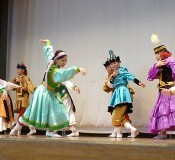
November 23, 2012 Ryukyu Shimpo
On November 22, a group of 16 children from an orphanage in Mongolia called “Children of the Sun,” gave a charity performance at Okinawa Shogaku High School. In addition to playing the traditional Mongolian stringed instrument called the matouqin, they performed a nomadic people’s dance and acrobatics. The local students were captivated by the performances.
Tomoko Teruya, a former student of Okinawa Shogaku High School and president of the non-government organization (NGO) “Yuimaru” set up to support and manage an orphanage in Mongolia, said, “All children possess equally infinite possibilities, wherever they were born, and in whatever circumstances that may have been in. Passion makes dreams come true.”
During their time in Okinawa, the children from Mongolia stayed in the houses of local host families. One of the children said, “I couldn’t be happier. My host mother has treated me as though I was one of her own children.”
At 4:00pm on November 25, children from Mongolia showed their traditional performing arts at the Ishikawa Hall in Uruma.
Please contact NGO Yuimaru by telephone on 050 3736 8012.
(English translation by T&CT, Mark Ealey)
Go to Japanese











 Webcam(Kokusai Street)
Webcam(Kokusai Street)


